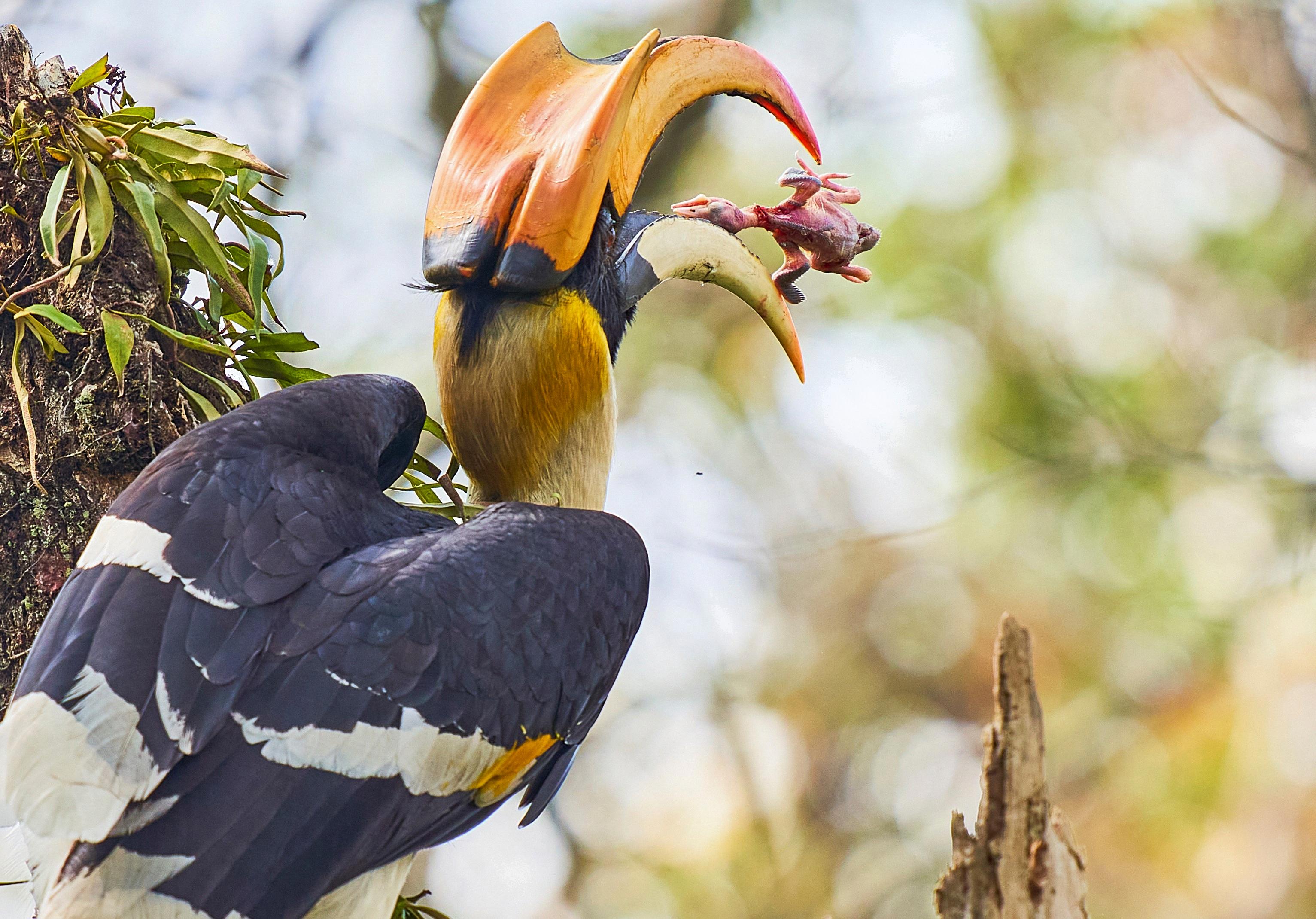The great hornbill is a magnificent bird that belongs to the family Bucerotidae, which is found in the tropical forests of Southeast Asia. It is one of the largest hornbills, measuring up to 1.3 meters in length and weighing up to 4 kilograms. It has a distinct appearance with a large, curved bill that is yellow in color, a black body with white patches on the wings and tail, and a helmet-like structure on the head.
The great hornbill is a frugivorous bird, meaning it feeds primarily on fruits. It has a unique way of feeding where it plucks fruits from trees and tosses them into the air before catching them in its mouth. This bird also feeds on insects, small mammals, and reptiles.
The great hornbill has a unique breeding behavior where the female seals herself inside a tree cavity uing her own feces and mud to create a nest, leaving only a small opening for the male to feed her and the chicks. This nesting behavior can last up to 4 months, and the male is responsible for providing food for the female and the chicks during this time.
The great hornbill is listed as a vulnerable species by the International Union for Conservation of Nature (IUCN) due to habitat loss and hunting for its meat and feathers. However, in some parts of its range, it is considered a sacred bird and is protected by local communities.
Conservation efforts are being made to protect the great hornbill and its habitat. Protected areas have been established, and conservation organizations are working with local communities to raise awareness about the importance of conserving this species.
The great hornbill is a magnificent bird with unique behaviors and a vital role in the ecosystem. It faces threats from habitat loss and hunting, but conservation efforts are underway to protect this species. It is crucial that we continue to work towards conserving the great hornbill and other endangered species to ensure the health and diversity of our planet’s ecosystems.
Estimated Number of Great Hornbills Left in the World
According to current estimates, the population of great hornbills is between 23,000 to 71,000 individuals globally. This estimate is based on consistent population densities within protected areas in western and northeastern India, as well as Thailand. However, this number roughly translates to 13,000 to 27,000 mature individuals. It is important to note that these numbers are subject to change as more research and surveys are conducted.

The Rarity of Hornbills
Hornbills are considered rare, especially some of their species that are classified as endangered, threatened, or vulnerable. Out of the 54 species of hornbills found worldwide, 13 of them are categorized as vulnerable, 8 are endangered, and 1 is critically endangered. The rufous-headed hornbill and the Sulu hornbill, two of the critically endangered species, are restricted to the Philippines and face imminent extinction. The latter species is considered one of the world’s rarest birds, with only 20 breeding pairs or 40 mature individuals. Therefore, the conservation of hornbill species is crucial to maintain their population and preserve their habitat.
Are Great Hornbills Related to Toucans?
Great hornbills are not related to toucans. Hornbills are an Old World group found in sub-Saharan Africa and Asia, while toucans are a New World group primarily found in Central and South America. Although they share some similarities, such as large, outlandish beaks, they belong to different families and have distinct evolutionary histories. Therefore, great hornbills and toucans are unrelated.
Conclusion
The great hornbill is a magnificent bird species that is found in the forests of South and Southeast Asia. Its striking appearance, with its large beak and colorful plumage, makes it a popular subject of fascination among bird enthusiasts. However, despite being a protected species, the great hornbill faces several threats to its survival, including habitat loss, hunting, and poaching. While its current population is estimated to be between 23,000 to 71,000 individuals, continued conservation efforts are necessary to ensure the long-term survival of this remarkable bird. With ongoing research and conservation efforts, we can hope to preserve the great hornbill for future generations to appreciate and admire.












